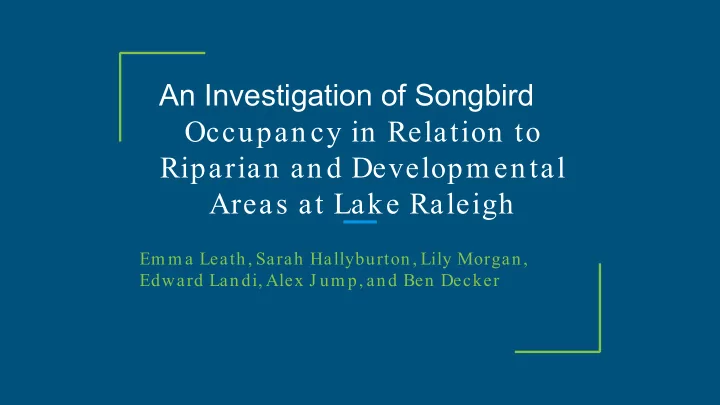

An Investigation of Songbird Occupancy in Relation to Riparian and Developm ental Areas at Lake Raleigh Em m a Leath, Sarah Hallyburton, Lily Morgan, Edward Landi, Alex J um p, and Ben Decker
Background Global songbird decline caused by urbanization (Owens and Bennett 2000) ● ○ Habitat destruction and fragmentation Riparian zones have shown to be important protectors of biodiversity when ● habitat is scarce (Montgomery 1996)
Objectives Establish occupancy estimates for 6 nonmigratory resident bird species in ● relation to riparian and developed habitats in an isolated forest habitat. ● Lake Raleigh Woods, Raleigh NC ● Determine if riparian habitat and development are key factors in songbird occupancy
Study Site Lake Raleigh Woods ● ● 96 acres ● Mixed hardwood/pine forest ● Riparian habitat on lake side ● Edge/buffer habitat on development side Site selected for its size, location, and availability of specific habitat types
Hypothesis There will be a higher rate of occupancy of non-migratory songbirds at points closer to the lake habitat compared to farther into the forest habitat due to the additional resources and niches available in the riparian zone. We also hypothesized that we would see a higher occupancy rate farther away from development.
Research Goals Estimate the occupancy of 6 species non-migratory songbirds in relation to riparian and urbanized habitat 1. Carolina Chickadee 2. Northern Cardinal 3. Tufted Titmouse 4. Pine Warbler 5. Carolina Wren 6. Brown-headed Nuthatch
Methods ● 20 total points 3 observers simultaneously and ● independently recording for 5 minutes at each point ● Sampling was conducted on three separate occasions in the morning from 0700 EST - 1000 EST
Methods Google maps was used to determine distance (m) of the points from the ● riparian zone as well as distance from human development ● We categorized human development as any man -made building or road that was not part of the forest ● All transects stemmed from the west side of the lake to avoid direct collision with human development
Methods ● Species recorded in field notebook and then placed into an Excel spreadsheet ● Data collected in an Excel spreadsheet was analyzed using program PRESENCE Three separate PRESENCE models were ran ● ● These models gave us a naive occupancy (whether or not the bird was marked present)
Results The following naive occupancy estimates were calculated for each species Carolina Chickadee - 1 Tufted Titmouse - 1 Northern Cardinal - 1 Pine Warbler - 0.9 Carolina Wren - 1 Brown-headed Nuthatch - 0.2
Results ∆AIC Brown-headed Nuthatch AIC Psi(distance from 71.65 0 development)p() Psi(distance from 72.41 0.76 water)p() 72.83 1.18 Psi()p()
Discussion Analysis for the Pine Warbler, Carolina Chickadee, Carolina Wren, Tufted ● Titmouse, and Northern Cardinal did not show proximity to water or development influencing their habitat use ● Brown-headed Nuthatch data analysis showed that proximity to water and development influenced habitat use
Discussion Proximity to water is less important than habitat and tree type (Glass and ● Floyd 2015) ● Brown-headed Nuthatches are cavity nesters, possibly limited by nesting habitat (O’Halloran and Conner 1987) ○ Snags and development?
Discussion Factors Affecting Detection ● Experience level of observers ● Background noise ● False positives due to relative location of each point count
Discussion Further Directions: ● Survey a larger variety of species ● Larger study area ● More repetitions to increase data size Overall: ● No solid evidence to make a conclusion based on correlations ● More research should be done in order to have optimal management of songbird habitats
Literature Cited Glass, J.R., and Floyd, C.H. 2015. Effects of proximity to riparian zones on avian richness and abundance in montane aspen woodlands. Journal of Field Ornithology 86(3):252-265 Montgomery, G.L. 1996. Riparian areas reservoirs of diversity. NRCS, USDA O’Halloran, K. and Conner, R. 1987. Habitat used by Brown -headed Nuthatches. Bulletin of the Texas Ornithological Society 20:7-13 Owens, I.P.F, and Bennett, P.M. 2000. Ecological basis of extinction risk in birds:habitat loss versus human persecution and introduced predators. PNAS 97(22): 12144-12148
Questions?
Recommend
More recommend